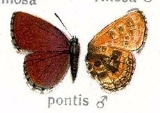
Orthomiella pontis
Encyclopedia
The Straightwing Blue is a small butterfly
found in India
that belongs to the Lycaenids or Blues
family.
Female upperside : dark brown. Fore wing: basal two-thirds brilliant purplish blue, much brighter than the purple sheen in the male. Hind wing: a medial area from base extended outwards for about two-thirds tho length of the wing, purplish blue as on the fore wing. This colour not extended anteriorly to the costa or posteriorly to the dorsum. Cilia of both fore and hind wings as in the male. Underside: ground-colour and markings similar to those of the male, but the latter somewhat more clearly and neatly defined; on the hind wing the irroration of black scales at base and on the posterior half of the wing less extensive. Antennae, head, thorax and abdomen as in the male.
Butterfly
A butterfly is a mainly day-flying insect of the order Lepidoptera, which includes the butterflies and moths. Like other holometabolous insects, the butterfly's life cycle consists of four parts: egg, larva, pupa and adult. Most species are diurnal. Butterflies have large, often brightly coloured...
found in India
India
India , officially the Republic of India , is a country in South Asia. It is the seventh-largest country by geographical area, the second-most populous country with over 1.2 billion people, and the most populous democracy in the world...
that belongs to the Lycaenids or Blues
Lycaenidae
The Lycaenidae are the second-largest family of butterflies, with about 6000 species worldwide, whose members are also called gossamer-winged butterflies...
family.
Description
Male upperside: deep purplish brown, the purple suffusion visible in some lights, not in others. Pore and hind wings: uniform, with dark brown, somewhat broad anticiliary lines. Cilia brown alternated with white. Underside: paler, somewhat silky brown. Fore wing: base thickly irrorated with black scales; cell transversely crossed in the middle and along the discocellulars by brown bars of a darker shade than the ground-colour of the wing; a transverse, somewhat irregular, catenulated, ducal, similarly coloured band followed by a slightly paler, transverse, narrow, lunular, subterminal broad line, beyond which the groundcolour is earthy-brown, with a superposed terminal series of lunate spots in the interspaces. The cellular and discal markings are faintly edged with white, the terminal markings are generally very obscure. Hind wing: base,-posterior half of cell and bases of interspaces 1a, 1, 2 and 3 densely irrorated with black scales with irregular small patches of paler scales superposed thereon; a transverse, catenulated, subbasal dark brown band, a similar shorter band from costa across the discocellulars and a similar very irregular discal band from costa, all merged posteriorly into the irrorarion of black scales, followed as on the fore wing by an obscure, transverse, lunular, subterminal brown line, and a terminal row of ill-defined, similarly coloured, lunate spots. Antenna dark brown, the shafts speckled with white; head, thorax and abdomen deep purplish brown; beneath: palpi, thorax and abdomen fuscous black.Female upperside : dark brown. Fore wing: basal two-thirds brilliant purplish blue, much brighter than the purple sheen in the male. Hind wing: a medial area from base extended outwards for about two-thirds tho length of the wing, purplish blue as on the fore wing. This colour not extended anteriorly to the costa or posteriorly to the dorsum. Cilia of both fore and hind wings as in the male. Underside: ground-colour and markings similar to those of the male, but the latter somewhat more clearly and neatly defined; on the hind wing the irroration of black scales at base and on the posterior half of the wing less extensive. Antennae, head, thorax and abdomen as in the male.

